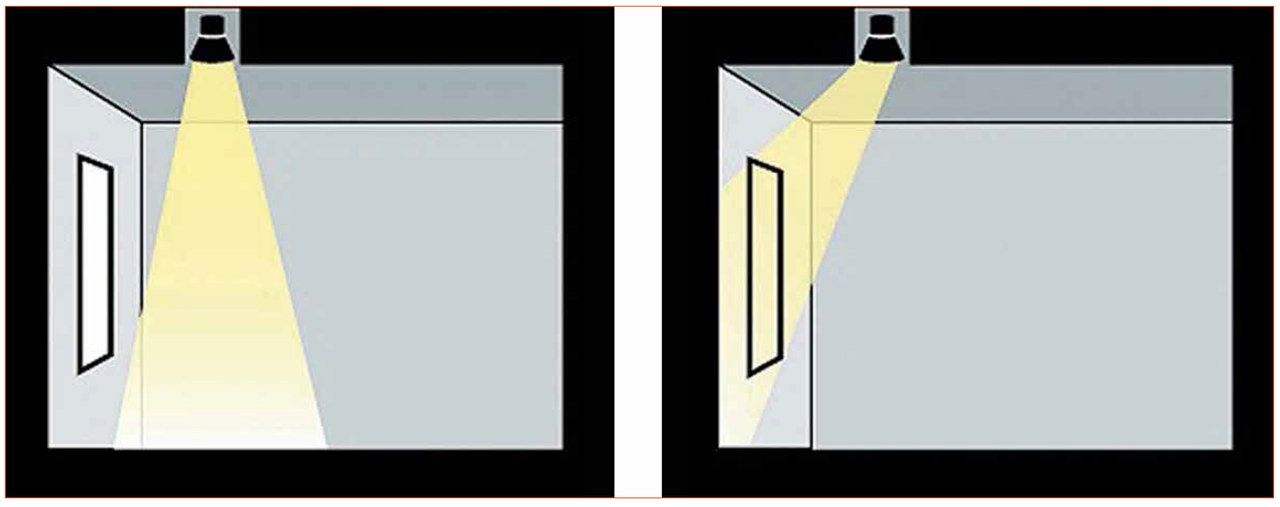The Role of Special Optics in Human Centric Lighting and Architecture by Suleyman Turgut and Luminit LLC
While Human Centric Lighting is relatively new and a topic of some debate, few can argue over the benefits of creating more natural lighting conditions in offices, retail spaces and other architectural settings. Anthony Ang, Optical Engineer, Suleyman Turgut, Director of Sales, and Mary Ann Giorgio, Marketing Communications Specialist at Luminit LLC show how special or “tertiary” optics, such as diffuser and direction film, can play a crucial role in Human Centric Lighting or lighting that takes into account the emotional and biological needs of humans.
Advocates of Human Centric Lighting call attention to the benefits of a lumen-rich environment.
Health problems associated with poorly-planned lighting, such as loss of concentration, sleep disorders, fatigue, and irritability, are well documented, and these symptoms can be intensified for those with photophobia or a high sensitivity to light as well as for those with reduced visual acuity.
As standard lamps and fixtures continue to be replaced with energy-efficient LEDs, lighting designers and manufacturers face new challenges. The light emitted from a bare LED is highly directional compared to conventional sources but still too divergent for spot lighting applications. The primary optic lens reduces the divergence in all directions and restricts the light to a narrower cone angle of around 80°. An additional secondary optic such as a reflector or TIR optic is required to further collimate it to around 10° to allow the light to illuminate objects greater than 1 meter away. A tertiary optic (i.e., diffuser, spread lens) is usually required as well to clean up any non-uniformity in the beam or modify the beam to the required shape and angle.
While color-changing LED bulbs that respond to human circadian rhythms, as well as advances in color temperature, illuminance and spread, are helping to improve SSL fixtures, even distribution is still difficult to achieve due to the concentrated and directional nature of LED light. LEDs also lack the intensity needed to effectively light a target plane more than half a meter away. Special optics such as diffusers and direction turning film incorporated during the design phase or out in the field can be an effective and economical way to control illuminance level, glare, uniform color temperature, beam direction and other factors that contribute to healthier or biophilic lighting.
The Role of Tertiary Optics in HCL
While secondary optics are essential to help collimate the beam, tertiary optics can take over where the capabilities of secondary optics end. For instance, HCL in a large retail store will be different from an office seeking to improve staff productivity through healthier lighting. Reflectors can have a counter-effect of glare when used in environments with shiny floors, and while TIR optics are effective collimation, they may not be as effective for downward recessed lighting where illumination needs to be diffused and cover a greater area. Such variances in applications is where tertiary optics such as Light Shaping Diffusers (LSDs) and prismatic optics such as Direction Turning Films (DTFs) can be helpful. Such beam shaping films can re-direct a light beam, enhance color uniformity, reduce glare and eliminate distracting LED hotspots. Tertiary optics can also aid designers faced with awkward spaces and less-than-ideal fixture placement.
Collimate then Expand
Light Shaping Diffusers use surface relief structures that are replicated from a holographically-recorded master. These pseudo random, non-periodic micro-structures manipulate light based on optical refraction by changing the direction of its energy. When applied to a lighting fixture or lamp, Light Shaping Diffusers allow the designer to shape a light beam to suit a particular need. LSDs can effectively improve the color and spatial uniformity, as well as reduce glare and multiple shadows. When incorporated into LED light strips, these diffusers can depixelate the LEDs, adjust the angle and improve uniformity of the secondary optics. This “collimate then expand” principle relies on a secondary optic to collect and collimate the light and a diffuser to expand the beam to the required beam angle.
 Figure 1: Effects created by a 60° x 1° elliptical Light Shaping Diffuser
Figure 1: Effects created by a 60° x 1° elliptical Light Shaping Diffuser
Figure 1 shows an example of the effects created by 60° x 1° elliptical Light Shaping Diffuser on an LED strip light. The light is shaped by spreading the horizontal direction 60° and only 1° in the vertical direction and the result is the elimination of hotspots, Moiré, color diffraction, etc.
The Role of Direction Turning Films in HCL
Direction Turning Film is another form of tertiary optics that gives designers greater control of beam angle. DTF is a non-symmetrical, linear micro-prismatic structure that imparts a 20° shift in the angle of a semi-collimated light source and is typically installed inside or above an LED-sourced luminaire or architectural feature. When combined with a Light Shaping Diffuser, the film allows designers to homogenize, redirect, and increase the beam angle of a light source. One of the major benefits of using DTF is that it allows for off-axis placement of an incoming beam, a feature that has many practical applications in human centric lighting.
 Figure 2: Direction turning films allow for off-axis placement of an incoming beam
Figure 2: Direction turning films allow for off-axis placement of an incoming beam
Figure 2 demonstrates how a direction turning film allows for off-axis placement of an incoming beam, and when combined with a Light Shaping Diffuser can shape and homogenize the beam in addition the changing its direction.
 Figure 3: Basic elements of a direction turning element and its fundamental working principle
Figure 3: Basic elements of a direction turning element and its fundamental working principle
Figure 3 shows the basic elements of a direction turning element and explains how it works. - A collimated light source enters from the left. The light is tilted 20° by the prismatic structure DTF then strikes the diffuser surface on the second side and spreads.
For example, we know that consumer behavior in retail stores is influenced by the shopper’s sense of well-being - if a shopper feels comfortable, he or she may stay and shop longer - and poor lighting, particularly glare, can have a negative effect on mood. Because linear fixtures are frequently located in the center of shopping aisles, glare resulting from light reflecting on a shiny floor can be distracting. DTFs placed below the secondary optics can redirect the light from the floor to the merchandise, thus illuminating both sides of the aisle without affecting the people below the fixture. Creating an atmosphere that is more conducive to comfort can be accomplished with existing fixtures and without changes to secondary optics.
An example of how tertiary optics such as light Shaping Diffusers (LSDs) and prismatic optics such as Direction Turning Films (DTFs) can be used in large retail store environments where linear fixtures are frequently located in the center of shopping aisle is shown in figure 4. These films can re-direct a light beam toward the display aisles and away from a shiny floor, thus reducing glare and creating a more pleasing shopping experience.

Figure 4: Application of light shaping diffusers and prismatic optics such as direction turning films in a large retail store environment
In recessed down lighting, direction turning film can be applied to lights mounted in close proximity to a wall. A light beam that would normally point downward and reflect off a table, counter or other surface, can be redirected 20° to highlight or “wash” the wall, thus turning directional light into volumetric room lighting. The prismatic structures of DTF can control directional light and provide better visual clarity, reduce glare and increase ground illumination in pathway/stairway lighting human centric conditions that can be especially helpful in hospitals and assisted living facilities. A diffuser placed on the opposite side of the film helps create a softer, more comfortable luminous environment as well as reduce shadows, glare and other factors that can lead to discomfort. DTFs can also be useful for in-grade lighting or recessed up-lights to direct the beam to the target wall or structure and improve illumination and coverage. The DTF film has also been successfully implemented in pool lighting where the beam can be diverted to the bottom of the pool without angling the fixture.
 Figure 5: DTF can also be used to create more pleasing and uniform coverage. The image shows an example of redirecting pool lighting
Figure 5: DTF can also be used to create more pleasing and uniform coverage. The image shows an example of redirecting pool lighting
Figure 5 shows an additional application example beyond common problems associated with interior lighting structures, DTF can also be used to redirect pool lighting. In addition to creating more pleasing and uniform coverage, the film helps prevent the blinding effects swimmers experience when swimming toward lights located beneath the surface.
While DTFs have many practical applications in HCL, there are limitations designers need to take into account. The prismatic structure must face the LED, and DTFs are most effective when used on semi-collimated light over bare LEDs that produce large beam angles (more than 80°). The film can be placed directly on top of secondary optics but designers working with bare LEDs should allow some distance between the light and the film to avoid overheating.
Future Possibilities
While tertiary optics are primarily being used to enhance HCL in interior and architectural settings, DTFs are also being incorporated into avionic displays to provide optimal viewing angles for pilots and co-pilots. Other possibilities include sunlight harvesting for energy-efficient buildings where direction turning film can be applied to windows to re-direct sunlight toward the ceiling where it can be scattered downward to illuminate larger areas of the space.
The possibilities of these tertiary optics are limited only by the imagination and ingenuity of engineers, designers and the LED industry as a whole. However, the ability to shape light and send it where it is needed most without changes to the fixture allows designers to incorporate human centric lighting principles to even the most impractical rooms and spaces.

